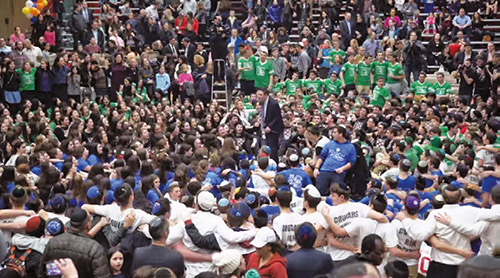
A colleague of my wife was bemoaning her daughter’s forthcoming college tuition expense. She became speechless, when my wife informed her that we have been paying tuition since pre-kindergarten for all of our children, so college did not have the same sticker shock. Sending our children to day schools and yeshivos is, obviously, an investment in our children’s ability to live an observant and literate Jewish life. We may argue about how to lower tuition, how to increase faculty salaries to attract the best teachers, how to allocate time to various subjects, single sex versus coed or why graduates are not fluent in Hebrew. However, there is general agreement that day school education—expensive as it is—is the best available option to maintain our Jewish heritage, traditions and future.
We have examined many aspects of day school education over the years in these pages. I want to focus now on the ruach experience. It’s not just NCSY, Pirchei, Bnos or summer camp. I believe that—over and above—all the book learning that our children receive, the intangible feeling one receives at a school event dancing and singing to pesukim or other inspirational lyrics and songs, creates a crucial and critical nexus to a child’s relationship to his/her Judaism. It’s not a tangible thing that can be easily measured. “Ruach” as the word implies is spiritual, transcendent, inestimable and immeasurable.
In chasidic thought, it is called the sha’ar haneginah, the gate of melody. One who enters is transported to another realm. One is elevated with a tune sitting around a Shabbos or Yom Tov table, or dancing arm-in-arm or hand-in-hand with one’s friends and teachers. A school chagigah, Shabbaton, Rosh Chodesh celebration or any other occasion when students join together in song—with or without musical accompaniment—is an uplifting experience. In my mind, it is a form of ammunition. I cannot envision someone who can enthusiastically dances and sings praises to Hashem getting totally lost on a college campus somewhere. I am not naïve enough to believe that it never happens, but this ammunition does make an impact.
I have observed the Frisch Shiriyah for many years. Each class presents their Jewish themed art, their class dance (is there a Jewish stomp?), and—finally—their songs. Watching the faces of these teenagers, as they earnestly sing their hearts out is very moving. It is after all a competition, but when the results are announced by Rabbi Ciner (Seniors!), the entire gym erupts in a marathon of ruach dancing and singing for the pure joy of it. Close to one thousand students— boys and girls separately—often with faculty joining in, singing and dancing exuberantly after the event is over. This goes on for almost an hour. No score is being kept, they are just happy and this joy is manifested by singing and dancing to sacred lyrics set to modern tunes. I can only say that listening to them dancing and shouting: “Hashem melech, Hashem moloch, Hashem yimloch l’olam va’ed”—even in a coed setting—was quite inspirational. If they can carry this exuberance and enthusiasm with them into college, all the tuition money was well-spent.
In a totally different environment, I see the same exuberance and enthusiasm at the Bais Yaakov high school where I teach. The girls—of course—have many ruach activities throughout the year. The future religiosity of these girls is safe, but the ruach aspect is an important component. Not only do they sing and dance during lunch, but often even during breaks, they—sometimes— break out in song and dance. This is not manufactured, it is genuine.
If our teenagers from all over the Jewish spectrum can carry this ruach forward; there is hope for the Jewish future.
Rabbi Dr. Wallace Greene can still remember the first tunes he learned in high school.









